
The zebra-tailed lizard is a species of lizard in the family Phrynosomatidae. The species is native to the Southwestern United States and adjacent northwestern Mexico. There are nine recognized subspecies.

The greater earless lizard is the only species in the monotypic genus Cophosaurus. It is closely related to the smaller, lesser earless lizards and other species in the genus Holbrookia, and in fact was placed in that genus and referred to Holbrookia texana from 1852 into the 1970s. Earless lizards lack external ear openings, an adaptation to burrowing in the sand, as are the recessed lower jaw and flared upper labial scales. Greater earless lizards are sexually dimorphic, males grow larger and are more colorful than females, exhibiting pink and green colors that are particularly bright in the breeding season. Two bold black bars mark the lateral region of males but are greatly reduced and vague, or occasionally entirely absent in females.
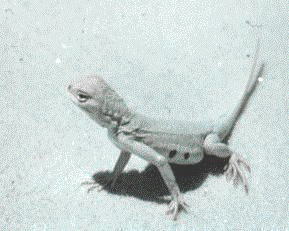
Holbrookia is a genus of earless lizards, known commonly as the lesser earless lizards, in the family Phrynosomatidae. The genus contains six recognized species, which are found throughout the Southwestern and Central United States and northern Mexico. They are characterized by having no external ear openings, presumably to prevent soil from entering their bodies when they are digging.

Plestiodon multivirgatus, commonly known as the many-lined skink, the northern many-lined skink, or the variable skink, is a medium-sized species of lizard, a member of the North American skink genus Plestiodon in the family Scincidae. The species is native to the western United States.

The western whiptail is a species of lizard in the family Teiidae. The species is found throughout most of the southwestern United States and northern Mexico. Most of its populations appear stable, and it is not listed as endangered in any of the states comprising its range. It lives in a wide variety of habitats, including deserts and semiarid shrubland, usually in areas with sparse vegetation; it also may be found in woodland, open dry forest, and riparian growth. It lives in burrows. Major differences between this species and the checkered whiptail include the lack of enlarged scales anterior to the gular fold and the presence of enlarged postantebrachial scales. It was previously known as Cnemidophorus tigris, until phylogenetic analyses concluded that the genus Cnemidophorus was polyphyletic. Since it does not migrate, a number of forms have developed in different regions, several of which have been given subspecific names – for example the California whiptail, Aspidoscelis tigris munda.

The gray-banded kingsnake, sometimes referred to as the alterna or the Davis Mountain king snake, is a species of nonvenomous snake in the family Colubridae. The species is endemic to the southwestern United States and adjacent Mexico. Some sources list two distinct subspecies of Lampropeltis alterna, as L. a. alterna and L. a. blairi differentiated by patterning and locale, but research has shown them to be color morphs of the same species.

Phyllodactylus xanti is a species of lizard in the family Phyllodactylidae. It is endemic to northwestern Mexico. It is also known as the leaf-toed gecko or Raza Island leaf-toed gecko when referring to the subspecies from the Isla Rasa; at present, there are altogether four recognized subspecies, while several more have been recognized previously.

The orange-throated whiptail is a species of lizard in the family Teiidae. The species was previously placed in the genus Cnemidophorus. Three subspecies are recognized as being valid, including the nominotypical subspecies.

The western long-tailed brush lizard is a species of lizard in the family Phrynosomatidae. The species is native to the southwestern United States and adjacent northern Mexico.
Holbrookia lacerata, commonly known as the spot-tailed earless lizard, is a species of phrynosomatid lizard.

Holbrookia propinqua, commonly known as the keeled earless lizard, is a species of phrynosomatid lizard.

The Texas spiny softshell turtle is a subspecies of the spiny softshell turtle in the family Trionychidae. The subspecies is native to the southwestern United States and adjacent northeastern Mexico.

Sceloporus merriami, commonly known as the canyon lizard, is a species of lizard in the family Phrynosomatidae. The species is native to the south-western United States and northern Mexico.
Holbrookia subcaudalis, commonly known as the southern spot-tailed earless lizard, is a species of lizard in the genus Holbrookia. It was previously considered a subspecies of Holbrookia lacerata.
Holbrookia maculata perspicua, commonly known as the eastern earless lizard and the prairie earless lizard, is a subspecies of lizard in the family Phrynosomatidae. H. m. perspicua is a subspecies of the lesser earless lizard. The subspecies is native to the prairies of the central United States.
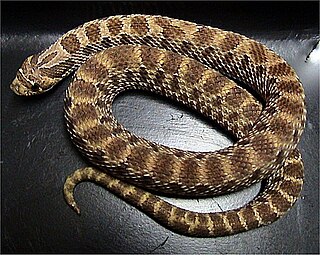
The western hognose snake is a species of snake in the family Colubridae. The species is endemic to North America. There are three subspecies that are recognized as being valid, including the nominotypical subspecies.
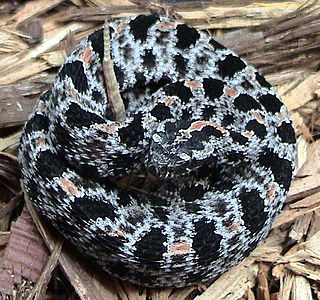
Sistrurus miliarius streckeri is a venomous pit viper subspecies found in the southcentral United States.
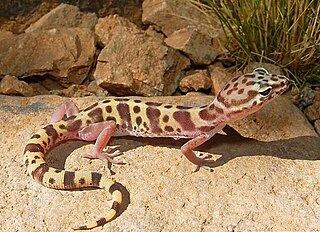
The western banded gecko is a species of lizard in the family Eublepharidae. The species is native to the southwestern United States and adjacent northwestern Mexico. Five subspecies are recognized.
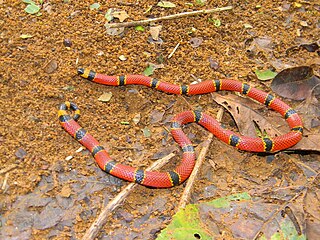
Micrurus browni, commonly known as Brown's coral snake, is a species of venomous snake in the family Elapidae. The species is native to Guatemala and southwestern Mexico. There are three recognized subspecies, including the nominate subspecies described here.

Sceloporus lundelli, also known commonly as Lundell's spiny lizard and la espinosa de Lundell in Mexican Spanish, is a species of lizard in the family Phrynosomatidae. The species is native to the Yucatán Peninsula in Mexico, Belize, and Guatemala. There are two recognized subspecies.


















